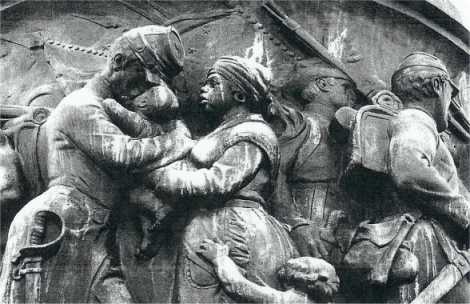Examples of Colored Service
Whereas the historians behind the documentary The Civil War: Blood and Honor deem enlistment of slaves in the Confederacy as "unthinkable," in his personal account, rebel veteran William Fletcher recalls a neighbor exclaiming, at the brink of war, that he could "arm [his] few negroes and run a whole company of Yanks out of the State."(6) Certainly something unthinkable would not be coupled to the sincere belief in superior Southern battle prowess.
 Although McPherson in his book on The Negro's Civil War
does note that a small number of blacks fought for the
Confederacy, he mostly equates "the Negro's contribution
during the Civil War" with service to the Union. The
brevity of his acknowledgement that groups of coloreds did
offer their service to Confederate government is striking,
but is likely due to the fact that they, unlike their Union
counterparts, did not end up serving in offical
ranks.(7) McPherson, eager to go against the
notion of negroes as "passive, docile, uncomprehending,"
still relucted to acknowledge active black participation in
the Confederate Cause.(8)
Although McPherson in his book on The Negro's Civil War
does note that a small number of blacks fought for the
Confederacy, he mostly equates "the Negro's contribution
during the Civil War" with service to the Union. The
brevity of his acknowledgement that groups of coloreds did
offer their service to Confederate government is striking,
but is likely due to the fact that they, unlike their Union
counterparts, did not end up serving in offical
ranks.(7) McPherson, eager to go against the
notion of negroes as "passive, docile, uncomprehending,"
still relucted to acknowledge active black participation in
the Confederate Cause.(8)
The notion that blacks were all siding for the North, waiting to be liberated, is "the framework of perception" that the Union soldiers brought South with them, says Rollins, who strongly disagrees with the premise that blacks fighting in the Southern ranks was a near impossibility.(9) Indeed, he writes that "stories of servants actually fighting are numerous."(10) The ubiquity of servants, and their hard work done in assistence of the Confederate armies, are widely recognized, so the greater part of his essays is uncontroversial; in addition, however, he asserts that the loyalty of many slaves to their masters, or rather to their homes and families, persuaded them to take up arms and join the battle.(11)
Rollins admits that, because there are no official records of Confederate blacks, apart from the units raised in 1865, "our knowledge [of fighting blacks] is exclusively anecdotal," and therefore resorts to using such anecdotes extensively.(12) Although he mainly emphasizes once more the ubiquity of servants, doing a variety of jobs in the vicinity of the armed forces, and most of the incidents he mentions involve loyal servants who take wounded masters home, or the forming and activity of colored music bands, he also cites a few relevant examples. For instance, he writes of a nameless sniper, who shot the first Union officer of the war; the remarkable "Negro marksman," spoken of by General Gordon at Fort Wagner; and a servant named Kelly. "Being black, Kelly was prohibited from officially joining, and no official records carry his name. Yet he donned a gray uniform and carried a gun."(13)
Ervin L. Jordan focuses specifically on what he dubs "Afro-Virginians," of whom "several thousand [...] and not just 'faithful body servants' [...] took up arms or otherwise volunteered for the South and staunchly worked in its behalf"; an assertion he bases on "reminiscenses, newspapers, and similar sources."(14) In slight contrast, however, most of his examples are of "Afro-Virginian civilians who were Confederate patriots," such as the slave who wouldn't take an oath of loyalty to the United States, exclaiming that "I can't take no oath that Massa won't take."(15) Other loyal blacks served as buglers and body servants, disregarding the possibility of running away.
According to J.H. Segars, blacks "in many cases joined the fight."(16) Together with Charles Kelly Barrow he has edited what can be seen as the most systematic attempts to promote the notion of black Confederates: a volume with a varied sample of sources, which they think delivers solid evidence that blacks indeed served in significant numbers in the Confederate armies. They have included a number of selections from the Official Records, listing the soldiers that partook in the war, and their testimonies; accounts of veterans; pension application forms and letters; historical acounts; and memorials.(17) Considering the ambitious aim, the result is somewhat disappointing: black Confederates are hard to find (or hardly to be found) in the Official Records; the only ones that come up easily are the Louisiana Native Guards, a local militia that did less fighting in Gray than it did in Blue, as they switched sides with the capture of New Orleans in 1862.(18) Veteran accounts usually speak of plans to arm slaves, or the familiar loyal body servants; the historical accounts are lengthy about a small number of individual spies or snipers; and pensions were applied for by a number of blacks who were wounded, but often merely accompanied the army.(19)
A final, perhaps more powerful tool of persuasion is the use of photographs. These photo's include both blacks and whites, either during the Civil War or at reunions of veterans. In the eyes of Barrow et al, the proximity of the blacks to white soldiers confirms the presence of blacks with the armies of the South, and pictures of them at reunions suggest an approval of the Cause.
